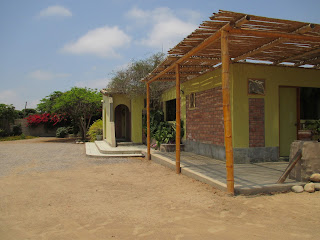part 2
As I’ve mentioned, el Carmen (and indeed, much of the region of Chincha) is known as a center of Afro-Peruvian culture. El Carmen and the nearby towns of San José, Guayabo and others maintain a very old Afro-Peruvian tradition called the “hatajos de negritos.”
As I’ve mentioned, el Carmen (and indeed, much of the region of Chincha) is known as a center of Afro-Peruvian culture. El Carmen and the nearby towns of San José, Guayabo and others maintain a very old Afro-Peruvian tradition called the “hatajos de negritos.”
This is a kind of
performance and procession that is part of the Christmas celebration, and also
the celebration of the Virgin of el Carmen, whose special day is December 28. I’ll add a video of the celebration later on
in this article.
 |
| the front drive to the bed and breakfast: Huaranjapo |
But first, I should tell you
about the bed and breakfast where I stayed.
It is on an estate that is a five minute walk from town. There is a lovely bungalow, and a couple of
small, outlying buildings that serve as additional guest rooms when the
bungalow is full. There is a swimming
pool. There is a patio. There are a couple of friendly dogs; and a nice couple that live in a tiny house near
the front gate and act as caretakers.
There is a small avocado orchard; a small guava orchard; a few banana trees; a large lawn;
lots of flowers…in sum, a lovely place.
And yes, it has an internet connection.
The only downside that I
encountered was – mosquitoes. Bring
insect repellent. Seriously.
The owner, Edith Maldonado,
is friendly and very well informed about Afro-Peruvian culture. She is a pillar (and former board member) of
one of the two cultural organizations in el Carmen. We had been corresponding for months, and she
introduced me to people in the town who helped me with my work.
I was there to film the town
(easy – it is a very small town) and the setting (lots of cotton fields, a
river that I never got to, and other small towns nearby – I saw the town of San
José very briefly). I was also there to
make contact with at least one cultural center;
and to film the rehearsals for the “hatajos de negritos.”
 |
| a street in the town - with the only two-storey building |
The residents of the town
are people of very modest means – so modest that I felt a little uncomfortable
coming from the lovely bed and breakfast where I was staying to talk to people
many of whose homes didn’t even have running water.
Although most own their own
farmland, many find work outside of town in larger places like Chincha. This is partly because a very few years ago,
the Peruvian government signed a trade deal with China that has brought Chinese
cotton into the country at a lower price than local cotton. Some townspeople would like to change over to
growing cacao, for which there is still a good market, but it takes three years
for the cacao plants to mature enough to bring in a serious crop, and the
townspeople don’t have the wherewithal to wait for three years with no farming
income.
 |
| a cotton field outside of town |
My filming of the town and
of one rehearsal of the “hatajos” went pretty smoothly, although getting the
required signature saying we’d filmed with permission turned out to be a bit
sticky (but in the end, we got what I needed).
We also went to the home where the second group of “hatajos” rehearses,
but they didn’t want to be filmed.
 |
| house of Margarita Córdova where one set of "hatajos" rehearsed |
I have since learned that
“everyone” comes to el Carmen to see the “hatajos” – and many people have
filmed them – so I guess people feel that they should get paid and that they
are being somewhat taken advantage of. I
can sympathize with this.
I'll give you a video with clips of the "hatajos" and an explanation of them in the next post.
I'll give you a video with clips of the "hatajos" and an explanation of them in the next post.
_________________
Eve A. Ma, a former
university professor, lawyer, and director of a non-profit cultural
organization, is the producer-director of two documentaries about
Afro-Peruvians: A Zest for Life and Masters
of Rhythm with addendum. Sign up for
her newsletter to keep up with her work and get a special video: www.PalominoPro-signup.com
















